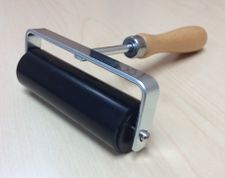Best Practices for Applying Barcodes
This page addresses the proper process for securely applying quality-checked pressure-sensitive barcodes (nameplates/labels) in sequential order.
TIP
Following strict application procedures will eliminate 95% of the non-sticking issues.
For information outlining the benefits of using TrackAbout barcode labels, please visit the Justification for TrackAbout Barcode Labels page.
For a brief video detailing this process, please review this video provided courtesy of Metalcraft, Inc.
Special Considerations
-
Bond strength increases with time, temperature, and pressure. If you can increase any or all of these, your bond strength will improve.
-
Service temperature is the temperature up to which adhesives can maintain bond strength. Some adhesives have a service temperature to 450 degrees F (232 degrees C.)
-
Small rollers for wallpaper seams, or label squeegees, work the best for getting the adhesive and label to flow evenly across the substrate, forcing the adhesive to bond better.

-
-
Ensure you have a clean surface to start. To ensure a strong bond, no dirt or debris should be present. Rubbing Alcohol and a lint free cloth will be best for cleaning.
-
Important Storage Information: Pressure-sensitive adhesive used on labels will retain its adhesive properties longer if stored in a cool, dry place (72°F or cooler, less than 50% relative humidity) away from direct heat or sunlight. Do not apply nameplates/labels when temperatures are 50°F or cooler.
Supplies Needed
-
Your order of quality-checked pressure-sensitive nameplates/labels in sequential order.
-
Cleaning solution to clean all surfaces prior to product application
OVERVIEW: Steps to be Executed
-
Find the best time of day to apply the labels, when the cylinder is not sweating and it is not in direct sunlight.
-
Clean the area with isopropyl alcohol and make sure it is dry.
-
Apply the label following the instructions on how to properly remove the label from the liner holding it by the edges at top and bottom of label.
-
Apply the label to the cylinder and apply even pressure over the entire label. If possible use a label squeegee or wallpaper roller for seams will work the best. This pressure helps to increase the bond strength evenly over the label, reducing flagging.
STEP 1: Clean Surface
It is extremely important that application surfaces are properly cleaned prior to product application.
Surfaces may be cleaned with an industrial cleaning solution(which your organization may already be using) or isopropyl alcohol.
All surfaces must be cleaned and completely dried to ensure adequate adhesion.
Plastic surfaces should be rubbed vigorously to remove the potential presence of mold release or silicone.
TIP
A permanent bond cannot be achieved if grease, oil, wax, moisture, silicone, mold release or dirt is present on the application surface.
Both new and used equipment surfaces must be cleaned thoroughly prior to application.
STEP 2: Handle with Care
Pressure-sensitive adhesive products should be handled only by the edges once the protective liner has been removed from the product.
Do not touch the exposed adhesive after the backing has been removed from the product.
NOTE
The pressure sensitive adhesive product should be applied immediately after the liner has been removed.



STEP 3: Bond Product
Apply the pressure-sensitive product firmly to a clean, dry surface.
Do not touch the adhesive backing while applying.
Use firm thumb pressure over the product surface to release the excess air.
Be sure that all edges have a secure bond.


References
Instructions and application photos provided courtesy of Metalcraft, Inc.
